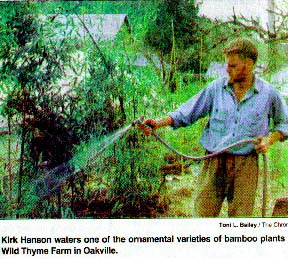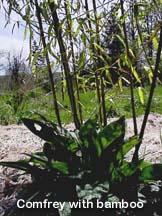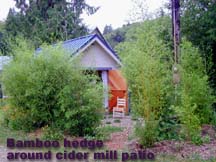 |
Agroforest Systems 1.Food 2.Bamboo Bamboo Research 3.Riparian Riparian Species Author's Page |
Bamboo Agroforestry As noted bamboo researcher Simon Henderson stated, "Bamboo thrives through socialization with human culture." This fact is no more obvious than in SouthEast Asia where the indigenous cultures have literally co-evolved for centuries with bamboo incorporating it into every aspect of their lives. The extraordinary capacity of bamboo to yield a wide range of products lends itself well to inclusion in a farm's landscape. Of bamboo's many potential yields and applications, the most significant include: edible shoots, poles for building or crafts, bioremediation, livestock forage, and ornamental hedgerows.
Bamboo is quite unique in the plant kingdom. In short it is but a giant grass sharing a not so distant relationship with the grass found in most lawns. Grasses are monocots with fibrous roots called rhizomes that spread laterally beneath the ground. Unlike trees, shrubs and other dicots, bamboo's point of growth is at their base or from their root system rather than at the tip of a branch. Lacking a cambium layer, emerging shoots never increase in diameter as they grow taller. Like other grasses, however, bamboo can dominate an ecosystem by suppressing competition and competing for available nutrients and resources; care must be taken to control its progress in the landscape, then, lest it become as invasive and noxious as the American lawn. As bamboo serves as the primary species in this particular agroforestry complex, the first objective is to provide for its needs. Bamboo is characterized by several requirements including adequate soil moisture, protection from harsh winds, and abundant nitrogen. By carefully siting bamboo in the landscape, many of its needs can be met naturally. Reading the landscape reveals the patterns implicit in nature's design and by working with and within these patterns bamboo groves can be woven into the fabric of the existing landscape. Native plants serve as excellent indicators of soil types and can be used as clues to the proper siting of bamboo. In our region, indicators of soil moisture adequate to the growing of bamboo are sedges (Carex spp.), reed canary grass (Phalaris arundinacea), and horsetail (Equisetum). Equally, soils rich in nutrients can be typically found beneath patches of brambles (Rubus spp.), stinging nettle (Urtica dioacea), and/or where animals were previously corralled on a farm. Protection from winds can be achieved by properly siting bamboo along forest edges or at the base of conifer trees. We have in several places planted bamboo along the southern edge of cedar trees to take advantage not only of the wind shadow the trees provide but also the heat reflected from their dark green foliage.
Now that the diverse productivity of the bamboo guild has been described let's look at the functionality of bamboo in the farm landscape. Bioremediation One of the prevailing challenges facing dairy, beef, and poultry operations is the management of animal wastes. Too often the high nitrates in concentrated manure and slurry storages either leaches into the ground water or enters streams via surface runoff during periods of high rainfall. Consequently farmers are faced with either constructing expensive containment facilities or paying large fines for the environmental impacts of their practices. The problem of nitrate accumulations on a farm can be looked at as a resource, however, when bamboo is applied to the scenario. Bamboo can tolerate enormous applications of nitrogen fertilizers accumulating it and turning it into biomass. By siting bamboo around manure containment ponds or between a nitrate sources and sensitive ecosystems, bamboo can be used to ameliorate a problem while simultaneously providing another marketable crop to the farmer. Animal forage On our farm where we run dairy cattle and goats on an open pasture we are faced with food shortages during the winter months when grasses are dormant or no longer meeting the nutritional needs of the animals. Consequently we have had to invest in either purchased feed or the energy and labor of cutting and storing grass hay. Recently we have begun exploring a number of perennial crops that hold the potential for extending the forage capacity of the bottomland pastures. Bamboo has become a prime candidate as a perennial forage species as it holds its foliage year round making dormant season harvest possible. Having a high protein content (12%-19%) it is comparable to alfalfa in nutritional value yet does not require the intensive cutting, drying, and storage process of an annual crop. Bamboo thrives in the rich, moist alluvial soils of the farm's bottomlands. We are therefore researching the feasibility of growing bamboo in proximity to grazing animals. Feeding can be managed by either cutting bamboo and "throwing it over the fence" or allowing animals to g raze in bamboo paddocks on short rotations. WSU is also experimenting with producing silage, a product of fermented foliage or biomass, from bamboo leaves. Silage is typically produced from grass hay and is a common strategy for providing a food source to grazing animals during seasons when pastures are dormant. Hedgerows and Windbreaks
Although bamboo is not likely to achieve the prominence nor wide range of application in the U.S. that it has achieved in Asia, its food value and wide range of other products and uses cannot be ignored and only stand to be more effectively promoted in domestic markets. Our research into bamboo production at the Wild Thyme Farm will hopefully fuel its continued introduction to other farms in our region.
|
|
|
|
|
|
www.wildthymefarm.com © 1998-2009 • 72 Mattson Road, Oakville WA 98568 USA. Tel: (360) 273-8892 |
 In the spring of 1998 Permaculture West received plant donations of over 30 varieties of bamboo with the intention of conducting varietal trials in a region where relatively little research has been done on the plant. Of these varieties, 12 were donated by WSU specifically for the purpose of observing pole and edible shoot production. As bamboo is capable of occupying a wide range of niches in the landscape we situated groves throughout various microclimates and have employed it in many on-site applications. The basic tenet of agroforestry is that polycultures can share in the resilience of natural ecologies; possible benefits for the farmer include wider economic opportunity, increased habitat for beneficial species, and lower management costs.* By designing bamboo into mixed-use agroforestry complexes we can maximize its functionality while integrating it with other production crops.
In the spring of 1998 Permaculture West received plant donations of over 30 varieties of bamboo with the intention of conducting varietal trials in a region where relatively little research has been done on the plant. Of these varieties, 12 were donated by WSU specifically for the purpose of observing pole and edible shoot production. As bamboo is capable of occupying a wide range of niches in the landscape we situated groves throughout various microclimates and have employed it in many on-site applications. The basic tenet of agroforestry is that polycultures can share in the resilience of natural ecologies; possible benefits for the farmer include wider economic opportunity, increased habitat for beneficial species, and lower management costs.* By designing bamboo into mixed-use agroforestry complexes we can maximize its functionality while integrating it with other production crops.  The nutrient needs of bamboo can best be met within the supporting arrangement of the associated agroforestry complex. Species in the legume family such as ceonothus, vetch, and eleagnus can be used to provide essential nitrogen. We have also begun experimenting with companion planting beans and peas beneath bamboo in order to produce a secondary crop while utilizing the natural trellis structure of the bamboo. Other notable plants useful for supplying a wider range of nutrients are comfrey (Ca), bracken fern (P), Equisetum (Si), and nettles. Stacking berry bushes into the system provides yet another harvestable crop while also attracting birds and the high nitrogen/ phosphorous droppings they deposit while visiting the site. Another often overlooked companionable species are mushrooms as they assist in the decomposition of the high cellulose leaf litter deposited by bamboo while also providing a premium marketable product. We have inoculated Stropharia rugosa into the mulch beneath some of our bamboo groves as it is an edible species that tolerates a wide range of environmental conditions.
The nutrient needs of bamboo can best be met within the supporting arrangement of the associated agroforestry complex. Species in the legume family such as ceonothus, vetch, and eleagnus can be used to provide essential nitrogen. We have also begun experimenting with companion planting beans and peas beneath bamboo in order to produce a secondary crop while utilizing the natural trellis structure of the bamboo. Other notable plants useful for supplying a wider range of nutrients are comfrey (Ca), bracken fern (P), Equisetum (Si), and nettles. Stacking berry bushes into the system provides yet another harvestable crop while also attracting birds and the high nitrogen/ phosphorous droppings they deposit while visiting the site. Another often overlooked companionable species are mushrooms as they assist in the decomposition of the high cellulose leaf litter deposited by bamboo while also providing a premium marketable product. We have inoculated Stropharia rugosa into the mulch beneath some of our bamboo groves as it is an edible species that tolerates a wide range of environmental conditions. There are many species of bamboo each growing to different heights and exhibiting different growth characteristics. We have begun using varieties of bamboo that produce very erect and rigid culms as windbreaks thereby protecting gardens and other agricultural systems from the damaging effects of either prevailing winds or the frosts that roll off the hillside. By carefully arranging these hedgerows in the landscape increases in crop productivity can be achieved on their leeward side as the desiccating effects of dry or winter winds is ameliorated. Hedgerows have also been observed to provide habitat for birds thus encouraging species diversity and additional nutrient distribution in the agricultural landscape.
There are many species of bamboo each growing to different heights and exhibiting different growth characteristics. We have begun using varieties of bamboo that produce very erect and rigid culms as windbreaks thereby protecting gardens and other agricultural systems from the damaging effects of either prevailing winds or the frosts that roll off the hillside. By carefully arranging these hedgerows in the landscape increases in crop productivity can be achieved on their leeward side as the desiccating effects of dry or winter winds is ameliorated. Hedgerows have also been observed to provide habitat for birds thus encouraging species diversity and additional nutrient distribution in the agricultural landscape.